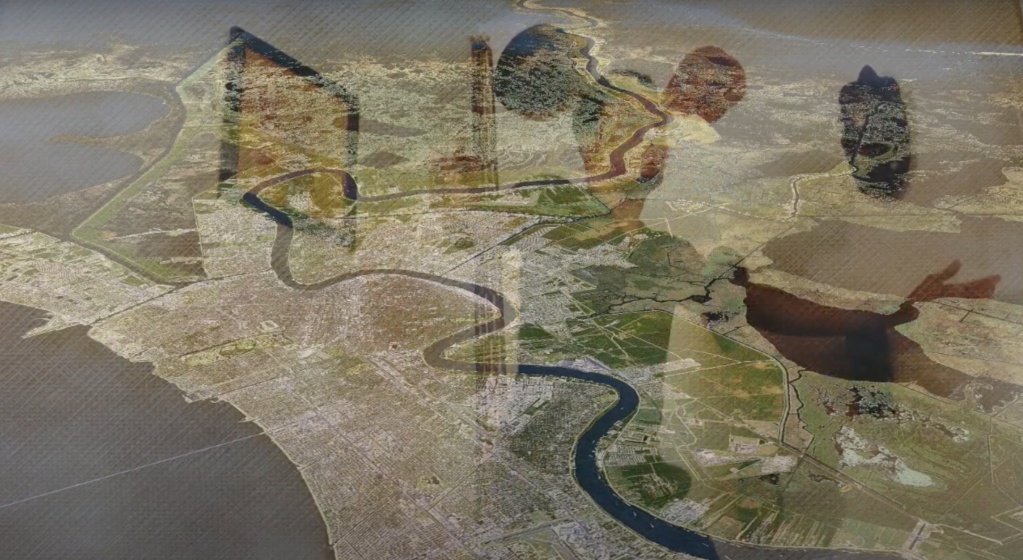As a dance maker, I develop collaborative place-based work. Across difference, my collaborators and I mobilize African diasporic techniques and contemporary modes of improvisation, collaboration, and place-based engagements in order to activate histories, spaces, and conversations. As a dance/ing researcher, I have spent 15 years deeply studying with Haitian artists in Haitian dance techniques, and trained with other master dance artists from Cuba, Brazil, Senegal, Mali, Guinea, Zimbabwe, Congo, as well as U.S. Euro-American postmodern and Afro-modern choreographers. As a performer, I have collaborated and made dances with choreographers in New York City, Haiti, and the U.S. South.

Fall 2020 – Fall 2021. “Tributaries.” Tè Glise Collective: myself with Jean-Sebastien Duvilaire, Ann Mazzocca Bellecci and Phil Rodriguez. Ongoing remote and in person collaboration exploring performance histories carried by the Mississippi river and related bodies of water. Screendance, embodied research, and co-authored essay.


“Tè Glise, Te Tremble.” Excavating Haiti-New Orleans Connections. Performed at A Studio in the Woods, and The Mint, New Orleans, LA. May-June 2018. Project conceived by Dasha Chapman. Created and Performed by Dasha Chapman, Jean-Sebastien Duvilaire, Ann Mazzocca, Phil Rodriguez, with New Orleans-based musicians Bruce Sunpie Barnes and Louis FanFan Damas. Cultivated in residence at A Studio in the Woods, as Adaptations|Living with Change 2018 Artist Residents, alongside New Orleans cultural practitioners and artists. http://www.astudiointhewoods.org/artist/dasha-chapman-jean-sebastien-duvilaire-ann-mazzocca-phil-rodriguez/

On August 12, 2017, the day white supremacists rallied in Charlottesville, VA, and confederate monuments entered again into national debate in the United States, we performed our response to public statues in the town square of Jérémie, Haiti. The public plaza’s monuments celebrate French and mixed-race identity and efface the Black revolutionary past: Ti Amelie, the small white French child greets visitors on one side; at the center stands Alexandre Dumas, Jérémie’s cherished author of mixed-race Haitian descent who penned The Three Musketeers; and what remains of the destroyed statue of Goman, a general of Jean-Jacques Dessalines representative of Black revolutionary political and aesthetic ideals. Through dance, song, text and music, this collaboration between three black Haitians and two white Americans directly engaged with and activated the racialized ideologies and submerged histories signified by the statues. This ritual aimed to resurrect Goman’s legacy and attend to the pain of the statue’s dismemberment.
The performance emerged after the first week of a dance education initiative spearheaded by Jean-Sebastien Duvilaire, a native of Les Abricots, Haiti, in the Gran d’Anse region of the nation (of which Jeremie is the capital)—a region which had been ravaged by Hurricane Matthew the previous October. Our students and co-facilitators participated in the performance by documenting, assisting with technical needs, and improvisationally demarcating space. Ultimately, the performance catalyzed new relationships and initiatives toward resuscitating Goman’s local legacy, ongoing in the present, following a devastating earthquake and hurricane in August 2021. The dance education project has taken root in the city and is also ongoing.


June – July 2017. A collaborative community endeavor, Hayti/Haiti/History was a trifold performance project grown from a public-oriented residency at the Power Plant Gallery in downtown Durham’s American Tobacco Campus. Over the course of the 6 week #PPGArtists residency, Aya Shabu and Dasha Chapman transformed the gallery into a space for story-sharing and creative exploration, tilted toward excavating local memories of Durham’s Hayti neighborhood and its real or imagined associations with Haiti, The First Black Republic. Through performance, experimentation, and dialogue we engaged local community actors and social practitioners in the creation of an archive for the future. https://haytihaitihistory.wordpress.com/

Activating Petwo’s Kinesthetic Imagination, site-specific performance collaboration in Port-au-Prince for the 4th Ghetto Biennale, December 2015. With Yonel Charles, Jean-Sebastien Duvilaire, and Ann Mazzocca.
Activating Petwo’s Kinesthetic Imagination mobilized the historical memory of the Haitian Revolution in the ways it is encoded in Vodou ritual and Haitian performance forms. My collaborators and I (two Haitians, two Americans) used the Haitian repertoire as our relational language across difference, and through performance buoyed the revolutionary potential of the strong female woman-loving Vodou spirit Ezili Dantò to urgently activate these resources toward more just ways of being in common.
The performance, reviewed in Art Forum (March 2016), was regarded as one of the most successful projects of the Biennale – https://www.artforum.com/print/reviews/201603/4th-ghetto-biennale-2015-58161.

“you should have told me…” collaboration with Thomas F. DeFrantz and Cindy Li, ChoreoLab, March 2016, Duke University.

“study no. 1: circles and lines.” collaborative choreography created with Ann Mazzocca for Field Studies creative residency at Chez Bushwick and Gibney Dance, NYC, May 2016.

“theory-ography 2.0: we still queer here” SLIPPAGE keynote performance at the Feminist Theory Workshop annual meeting at Duke University, March 2016.
